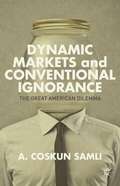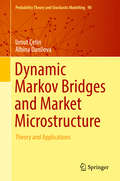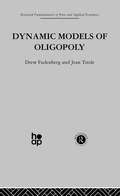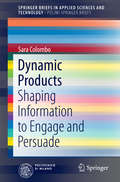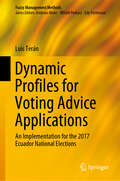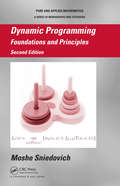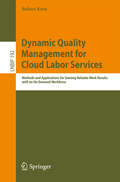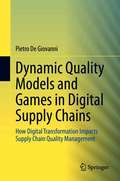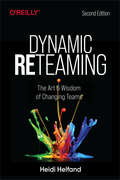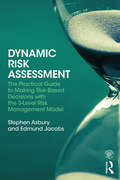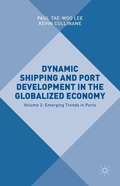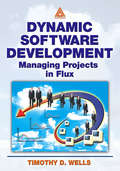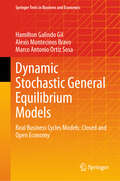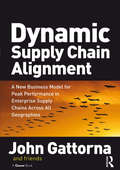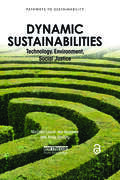- Table View
- List View
Dynamic Markets and Conventional Ignorance
by A. Coskun SamliA market economy is the only mechanism that can create jobs, distribute wealth, spur economic growth, and stabilize the economy for all. However, the current American market economy is not working - it is helping the "1%" instead of distributing wealth and yet simultaneously convincing the "99%" that this market is the only way to create jobs. The current unchecked system allows those wealthy few to "steal the American dream," as Hedrick Smith claimed. In order for the United States to grow the economy, the current system must first be modified to level the playing field, and then must be used to develop the market system's originally intended purpose: improving the quality of life for all. In this follow up to From a Market Economy to a Finance Economy, Samli reflects on his more than half a century of economic experience and research, maintaining that financiers, the government, and many decision makers in both politics and the economy, do not really support the "free market. " He puts forth key ideas for using the market mechanism correctly to benefit all Americans.
Dynamic Markov Bridges and Market Microstructure: Theory And Application (Probability Theory and Stochastic Modelling #90)
by Umut Çetin Albina DanilovaThis book undertakes a detailed construction of Dynamic Markov Bridges using a combination of theory and real-world applications to drive home important concepts and methodologies. In Part I, theory is developed using tools from stochastic filtering, partial differential equations, Markov processes, and their interplay. Part II is devoted to the applications of the theory developed in Part I to asymmetric information models among financial agents, which include a strategic risk-neutral insider who possesses a private signal concerning the future value of the traded asset, non-strategic noise traders, and competitive risk-neutral market makers. A thorough analysis of optimality conditions for risk-neutral insiders is provided and the implications on equilibrium of non-Gaussian extensions are discussed.A Markov bridge, first considered by Paul Lévy in the context of Brownian motion, is a mathematical system that undergoes changes in value from one state to another when the initial and final states are fixed. Markov bridges have many applications as stochastic models of real-world processes, especially within the areas of Economics and Finance. The construction of a Dynamic Markov Bridge, a useful extension of Markov bridge theory, addresses several important questions concerning how financial markets function, among them: how the presence of an insider trader impacts market efficiency; how insider trading on financial markets can be detected; how information assimilates in market prices; and the optimal pricing policy of a particular market maker.Principles in this book will appeal to probabilists, statisticians, economists, researchers, and graduate students interested in Markov bridges and market microstructure theory.
Dynamic Modeling and Applications for Global Economic Analysis
by Elena I. Ianchovichina Terrie L. WalmsleyA sequel to Global Trade Analysis: Modeling and Applications (Cambridge University Press, 1996, edited by Thomas W. Hertel), this new volume presents the technical aspects of the Global Trade Analysis Program's global dynamic framework (GDyn) and its applications within important global policy issues. The book covers a diverse set of topics including trade reform, growth, investment, technology, demographic change, and the environment. Environmental issues are particularly well-suited for analysis with GDyn, and this volume covers its uses with climate change, resource use, and technological progress in agriculture. Other applications presented in the book focus on integration issues such as rules governing foreign investment, e-commerce regulations, trade in services, harmonization of technical standards, sanitary and photo-sanitary regulations, streamlining of customs procedures, and demographic change and migration.
Dynamic Modeling, Empirical Macroeconomics, and Finance
by Lucas Bernard Unurjargal NyambuuThis edited volume, with contributions by area experts, offers discussions on a range of evolving topics in economics and social development. At center are important issues central to sustainable development, economic growth, technological change, the economics of climate change, commodity markets, long wave theory, non-linear dynamic models, and boom-bust cycles. This is an excellent reference for academic and professional economists interested in emerging areas of empirical macroeconomics and finance. For policy makers and curious readers alike, it is also an outstanding introduction to the economic thinking of those who seek a holistic and all-compassing approach in economic theory and policy. Looking into new data and methodology, this book offers fresh approaches in a post-crisis environment. Set in a profound understanding of the diverse currents within the many traditions of economic thought, this book pushes the established frontiers of economic thinking. It is dedicated to a leading scholar in the areas covered in this book, Willi Semmler.
Dynamic Models and Inequality: The Role of the Market Mechanism in Economic Distribution (Contributions to Economics)
by Robin MaialehThis book examines empirical and theoretical research on economic inequality from the perspective of dynamic models. By using advanced mathematical tools, it reveals fundamental market dynamics and underlines the role of subsistence constraints and competition in economic distribution.
Dynamic Models for Volatility and Heavy Tails
by Andrew C. HarveyThe volatility of financial returns changes over time and, for the last thirty years, Generalized Autoregressive Conditional Heteroscedasticity (GARCH) models have provided the principal means of analyzing, modeling, and monitoring such changes. Taking into account that financial returns typically exhibit heavy tails - that is, extreme values can occur from time to time - Andrew Harvey's new book shows how a small but radical change in the way GARCH models are formulated leads to a resolution of many of the theoretical problems inherent in the statistical theory. The approach can also be applied to other aspects of volatility, such as those arising from data on the range of returns and the time between trades. Furthermore, the more general class of Dynamic Conditional Score models extends to robust modeling of outliers in the levels of time series and to the treatment of time-varying relationships. As such, there are applications not only to financial data but also to macroeconomic time series and to time series in other disciplines. The statistical theory draws on basic principles of maximum likelihood estimation and, by doing so, leads to an elegant and unified treatment of nonlinear time-series modeling. The practical value of the proposed models is illustrated by fitting them to real data sets.
Dynamic Models of Oligopoly (Fundamentals Of Pure And Applied Economics Ser. #Vol. 1)
by D. Fudenberg J. TiroleFudenberg and Tirole use the game-theoretic issues of information, commitment and timing to provide a realistic approach to oligopoly.
Dynamic Negotiation: Seven Propositions About Complex Negotiations
by Michael D. WatkinsChallenges conventionally held views of negotiations, arguing that they are simplistic, static, and sterile. Develops seven propositions about real-world negotiations emphasizing the impact of complexity and the need for learning and adaption.
Dynamic Network User Equilibrium (Complex Networks and Dynamic Systems #5)
by Terry L. Friesz Ke HanThis book presents advanced research in a relatively new field of scholarly inquiry that is usually referred to as dynamic network user equilibrium, now almost universally abbreviated as DUE. It provides the first synthesis of results obtained over the last decade from applying the differential variational inequality (DVI) formalism to study the DUE problem. In particular, it explores the intimately related problem of dynamic network loading, which determines the arc flows and effective travel delays (or generalized travel costs) arising from the expression of departure rates at the origins of commuter trips between the workplace and home. In particular, the authors show that dynamic network loading with spillback of queues into upstream arcs may be formulated as a differential algebraic equation system. They demonstrate how the dynamic network loading problem and the dynamic traffic user equilibrium problem may be solved simultaneously rather than sequentially, as well as how the first-in-first-out queue discipline may be maintained for each when Lighthill-Whitham-Richardson traffic flow theory is used. A number of recent and new extensions of the DVI-based theory of DUE and corresponding examples are presented and discussed. Relevant mathematical background material is provided to make the book as accessible as possible.
Dynamic Oligopolies with Time Delays
by Ferenc Szidarovszky Akio MatsumotoThis is the first book to comprehensively examine the asymptotic behavior of dynamic monopolies, duopolies, and oligopolies where firms face information and implementation delays. It considers discrete and continuous timescales, continuously distributed delays, as well as single and multiple delays. It also discusses models with linear and hyperbolic price functions in three types of oligopolies: Cournot competition with quantity-adjusting firms, Bertrand competition with price-adjusting firms, and mixed oligopolies with both types of firms. In addition to the traditional Cournot-Nash equilibria, it introduces cases of partial cooperation are also introduced, leading to the analysis of cartelizing groups of firms and possible governmental actions against antitrust behavior. Further, the book investigates special processes for firms learning about the uncertain price function based on repeated market information. It addresses asymptotic properties of the associated dynamic systems, derives stability conditions, identifies stability switching curves, and presents in global analyses of cases of instability. The book includes both theoretical results and computer studies to illustrate and verify the theoretical findings.
Dynamic Optimization in Environmental Economics
by Willi Semmler Elke Moser Gernot Tragler Vladimir M. VeliovThe book presents new developments in the dynamic modeling and optimization methods in environmental economics and provides a huge range of applications dealing with the economics of natural resources, the impacts of climate change and of environmental pollution, and respective policy measures. The interrelationship between economic activities and environmental quality, the development of cleaner technologies, the switch from fossil to renewable resources and the proper use of policy instruments play an important role along the path towards a sustainable future. Biological, physical and economic processes are naturally involved in the subject, and postulate the main modelling, simulation and decision-making tools: the methods of dynamic optimization and dynamic games.
Dynamic Products
by Sara ColomboThis book explores how dynamic changes in products' sensory features can be used to convey information to the user in an effective and engaging way. The aim is to supply the reader with a clear understanding of an important emerging area of research and practice in product design, referred to as dynamic products, which is opening up new possibilities for the integration of product design with digital and smart technologies and offering an alternative to the use of digital interfaces. Dynamic products are artifacts displaying sensory characteristics - visual, tactile, auditory, or olfactory - that change in a proactive and reversible way over time, addressing one or more of the user's senses. The reader will learn why and how to communicate by means of such dynamic products. Their potential advantages and limitations are identified and design tools are proposed to support the design activity. It is hoped that the book will stimulate the design community to reflect upon the ever more compelling need to merge the virtual and the material in the information society by exploiting technological possibilities in order to create more meaningful and involving experiences.
Dynamic Profiles for Voting Advice Applications: An Implementation for the 2017 Ecuador National Elections (Fuzzy Management Methods)
by Luis TeránElectronic participation is an emerging and growing research area that makes use of internet solutions to enhance citizens' participation in government processes in order to provide a fair and efficient society. This book examines recommender-system technologies and voting advice applications as tools to enable electronic citizen participation during election campaigns. Further, making use of fuzzy classification, it provides an evaluation framework for eParticipation. A dynamic voting advice application developed for the 2017 Ecuador national election serves as a real-world case study to introduce readers to the practical implementation and evaluation issues. The book concludes with a comprehensive analysis of the 2017 election project based on altmetrics, Google Analytics and statistics from the case study.
Dynamic Programming: Foundations and Principles, Second Edition (Chapman & Hall/CRC Pure and Applied Mathematics)
by Moshe SniedovichIncorporating a number of the author's recent ideas and examples, Dynamic Programming: Foundations and Principles, Second Edition presents a comprehensive and rigorous treatment of dynamic programming. The author emphasizes the crucial role that modeling plays in understanding this area. He also shows how Dijkstra's algorithm is an excellent exampl
Dynamic Quality Management for Cloud Labor Services
by Robert KernHow can a scalable and efficient quality management mechanism for cloud labor services be designed in a way that it delivers results with a well-defined level of quality to the requester? Cloud labor services are a specific form of crowdsourcing: A coordination platform serves as an interface between requesters who need to get work done and a large crowd of workers who want to perform work. An early example of such a platform is Amazon's Web marketplace Mturk, on which service requesters can publish open calls for so-called human intelligence tasks (HITs). Robert Kern's work makes a considerable contribution toward solving the quality problem for scalable human work. On the basis of a comprehensive framework of cloud labor, he develops a set of methods to conceptually measure and aggregate the quality of human work results, implements a platform to put those methods to work, and evaluates their application in a number of very compelling, real-world scenarios successfully combining concepts from statistics, information technology, and management. Reading this book will be beneficial to novices in cloud labor services looking for orientation in this new field as well as to advanced researchers and practitioners developing cloud quality concepts.
Dynamic Quality Models and Games in Digital Supply Chains: How Digital Transformation Impacts Supply Chain Quality Management
by Pietro De GiovanniThis book bridges the fields of Supply Chain Management, Digital Transformation, and Dynamic Quality models in order to illustrate how digital transformation affects the work of researchers and managers in Supply Chain Quality problems. It aims to address the gap in scholarship regarding new technologies, updating the established literature to reimagine theoretical models, dynamic games, knowledge management, supply chain coordination solutions, interfaces in circular economies, and other functional spaces for a digital era. Written for researchers, managers, and practitioners, this book offers an accessible approach to the topics through clear, management-oriented chapters, reserving mathematical background for the Appendices. It discusses an array of modern challenges in digitization, including smart device installation, Cloud data accessibility, applications of AI systems, Supply Chain monitoring via Blockchains, using sensors in operations, and digital tool integration within traditional IS frameworks.
Dynamic Reteaming: The Art and Wisdom of Changing Teams
by Heidi HelfandYour team will change whether you like it or not. People will come and go. Your company might double in size or even be acquired. In this practical book, author Heidi Helfand shares techniques for reteaming effectively. Engineering leaders will learn how to catalyze team change to reduce the risk of attrition, learning and career stagnation, and the development of knowledge silos.Based on research into well-known software companies, the patterns in this book help CTOs and team managers effectively integrate new hires into an existing team, manage a team that has lost members, or deal with unexpected change. You’ll learn how to isolate teams for focused innovation, rotate team members for knowledge sharing, break through organizational apathy, and more.You’ll explore:Real-world examples that demonstrate why and how organizations reteamFive reteaming patterns: One by One, Grow and Split, Isolation, Merging, and SwitchingTactics to help you master dynamic reteaming in your companyStories that demonstrate problems caused by reteaming anti-patterns
Dynamic Risk Assessment: The Practical Guide to Making Risk-Based Decisions with the 3-Level Risk Management Model
by Stephen Asbury Edmund JacobsDynamic Risk Assessment is the key tool to support a holistic risk management framework. This book aims to help employers, managers and staff alike to understand how they can effectively integrate dynamic risk assessment into business management processes and systems to improve safety. With tips, examples and solutions throughout, this multi-disciplinary text delivers an effective and comprehensive approach to help you to understand how dynamic risk assessment (DRA) can be integrated into predictive (PRA) and strategic risk assessments (SRA) to enhance your organization’s effectiveness. The 3-Level Risk Management Model fully supports and complements the systematic ‘five steps to risk assessment’ process A multi-disciplinary approach to dynamic risk assessment that covers workers operating in teams and those working alone within the public, private and third sectors Contains practical examples, tips and case studies drawn from a wide range of organizations The book comes with access to downloadable materials from an accompanying website at: www.routledge.com/cw/dynamic-risk-assessment
Dynamic Shipping and Port Development in the Globalized Economy: Volume 2: Emerging Trends In Ports
by Paul Tae-Woo Lee Kevin CullinaneThis two volume book presents an in-depth analysis of many of the most important issues facing today's shipping and port sectors. Volume 2 of Dynamic Shipping and Port Development in the Globalized Economy focuses on the emerging trends in ports.
Dynamic Software Development: Managing Projects in Flux
by Timothy WellsThe ever changing nature of information makes the job of managing software development notoriously difficult. Dynamic Software Development: Managing Projects in Flux eases the burden by defining the principles, practices, skills, and techniques needed to manage a dynamic development environment. At a hands-on level, the text helps managers define t
Dynamic Stochastic General Equilibrium Models: Real Business Cycles Models: Closed and Open Economy (Springer Texts in Business and Economics)
by Hamilton Galindo Gil Alexis Montecinos Bravo Marco Antonio Ortiz SosaThis textbook guides the student step-by-step in developing and solving a DSGE (Dynamic Stochastic General Equilibrium) model–not only from the technical and conceptual aspects but also through the simulation process of each model. Characterized by a learning-by-doing approach, the book is set apart from the extant textbooks in three ways. First, it performs all the algebra associated with each model, such as the calculation of steady-state and the log-linearization of the model. Second, each model developed has been generated in Dynare, and every chapter is accompanied by a set of codes (mod-files and m-files) that the reader can use to replicate the model developed in every chapter. Finally, the models considered are toy models in the closed and open economy, which allows the student to learn the basic lessons and understand the fundamental relationships of the variables. All of this prepares the student to deal with more complex models. This book is intended for advanced undergraduate or beginning graduate courses in economics, finance, or applied mathematics, as well as practitioners in central banks that use these models daily in the preparation of forecasts or simulations of aggregate variables.
Dynamic Strategy-Making
by Thomas G. Cummings Larry E. GreinerPraise for Dynamic Strategy-Making"An astonishingly timely, hopeful, and important book that recasts and freshly imagines strategy-making and integrates theory with practice in the field of strategic management. A must-read for all those who want to learn more about the future of strategy practice and become more skillful at it." -Warren Bennis, Distinguished Professor of Business, University of Southern California; and coauthor, Transparency"This is one of the most valuable resources ever created for strategists and leaders in organizations. It uniquely combines concepts of leadership and organization with strategy content and implementation in a pragmatic and integrated approach that makes tremendous sense for our times. With concrete cases, it provides a clear road map for those who want and need to do a better job of formulating and implementing strategy." -David A. Nadler, vice chairman, Marsh & McLennan Companies; senior partner, Oliver Wyman-Delta Organization and Leadership; and author, Building Better Boards and Competing By Design"The authors correctly focus on the new dynamic of 24/7 competition and change and the need for organizations to be fast, fluid, and flexible. It is a must-read for managers of tomorrow and offers a number of practical insights and lessons on how to proceed with strategy execution that can be readily adopted in any organization. It is a call to action that few can afford to ignore." -Manjit Singh, chairman, Sony Entertainment Television, India; and former CEO, Compete Inc., High Circle, Future Step, and Korn/Ferry International
Dynamic Supply Chain Alignment: A New Business Model for Peak Performance in Enterprise Supply Chains Across All Geographies
by John GattornaJust like the world financial system, but for different reasons, 21st-century corporations need a new business model for their enterprise supply chains. The old conventions no longer work in this new world of volatile and increasingly unpredictable demand and supply. The enterprise needs to become more 'connected' to its own parts, as well as its partners up and down the chains it participates in. So too, we need to embrace new ways of looking at customers to gain deeper, more insightful impressions of what they are telling us about the way they want to buy our products and services. Finally, these signals need converting into corresponding action, driven by the people in the business, leaders and staff alike, who are aligned to their customers' wishes. This is the world of dynamic supply chain alignment where, increasingly, supply chains are the business. In the follow-up to his hugely successful Strategic Supply Chain Alignment, John Gattorna's Dynamic Supply Chain Alignment, explores how to create and sustain multiple supply chains with a level of flexibility and responsiveness that allow you to respond to opportunities and threats; at the same time aligning with your suppliers, your partners and your customers. When more executives get to this stage of development the profits will flow more readily, and sustainability of performance will not be the same issue it is today. The way forward is right there in front of us; but, says John Gattorna, we must throw off old ways and embrace the new.
Dynamic Sustainabilities: "Technology, Environment, Social Justice"
by Ian Scoones Melissa Leach Andrew Charles StirlingLinking environmental sustainability with poverty reduction and social justice, and making science and technology work for the poor, have become central practical, political and moral challenges of our times. These must be met in a world of rapid, interconnected change in environments, societies and economies, and globalised, fragmented governance arrangements. Yet despite growing international attention and investment, policy attempts often fail. Why is this, and what can be done about it? How might we understand and address emergent threats from epidemic disease, or the challenges of water scarcity in dryland India? In the context of climate change, how might seed systems help African farmers meet their needs, and how might appropriate energy strategies be developed? This book lays out a new 'pathways approach' to address sustainability challenges such as these in today's dynamic world. Through an appreciation of dynamics, complexity, uncertainty, differing narratives and the values-based aims of sustainability, the pathways approach allows us to see how some approaches are dominant, even though they do not produce the desired results, and how to create successful alternative 'pathways' of responding to the challenges we face. As well as offering new ways of thinking about sustainability, the book also suggests a series of practical ways forward - in tools and methods, forms of political engagement, and styles of knowledge-making and communication. Throughout the book, the practicalities of the pathways approach are illustrated using four case studies: water in dryland India, agricultural seeds in Africa, responses to epidemic disease and energy systems/climate change. Published in association with the Economic and Social Research Council (ESRC)
Dynamic Systems In Management Science
by Alexis LazaridisDynamic Systems in Management Science explores the important gaps in the existing literature on operations research and management science by providing new and operational methods which are tested in practical environment and a variety of new applications.
